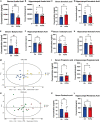Gut microbiota-generated short-chain fatty acids are involved in para-chlorophenylalanine-induced cognitive disorders
- PMID: 36419424
- PMCID: PMC9676499
- DOI: 10.3389/fmicb.2022.1028913
Gut microbiota-generated short-chain fatty acids are involved in para-chlorophenylalanine-induced cognitive disorders
Abstract
Neurocognitive disorders (NCDs) include complex and multifactorial diseases that affect many patients. The 5-hydroxytryptamine (5-HT) neuron system plays an important role in NCDs. Existing studies have reported that para-chlorophenylalanine (PCPA), a 5-HT scavenger, has a negative effect on cognitive function. However, we believe that PCPA may result in NCDs through other pathways. To explore this possibility, behavioral tests were performed to evaluate the cognitive function of PCPA-treated mice, suggesting the appearance of cognitive dysfunction and depression-like behavior. Furthermore, 16S rRNA and metabolomic analyses revealed that dysbiosis and acetate alternation could be related to PCPA-induced NCDs. Our results suggest that not only 5-HT depletion but also dysbiosis and acetate alternation contributed to PCPA-related NCDs. Specifically, the latter promotes NCDs by reducing short-chain fatty acid levels. Together, these findings provide an alternative perspective on PCPA-induced NCDs.
Keywords: cognitive disorders; dysbiosis; gut microbiota; para-chlorophenylalanine (PCPA); short-chain fatty acids (SCFAs).
Copyright © 2022 Liu, Li, Sun, He, Xiang and Xiong.
Conflict of interest statement
The authors declare that the research was conducted in the absence of any commercial or financial relationships that could be construed as a potential conflict of interest.
Figures




References
-
- Baba T., Takeda A., Murakami A., Koga T., Isomura T., Mori E. (2022). Effect of donepezil for dementia prevention in Parkinson’s disease with severe hyposmia (The Dash-Pd study): A randomized long-term placebo-controlled trial. EClinicalMedicine 51:101571. 10.1016/j.eclinm.2022.101571 - DOI - PMC - PubMed
LinkOut - more resources
Full Text Sources

